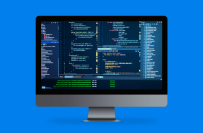Ava와 채팅 - AI 비즈니스 컨설턴트
안녕하세요. 저는 당신의 비즈니스를 강화시키도록 도와주는 AI 가이드 Ava입니다!
이미 사업을 운영하고 있거나 사업을 새로 시작하는 것을 바라신다면 저는 AI 기반 프리랜서를 사용하여 고객님의 비전을 현실로 바꾸는 데 도움을 드리고자 왔습니다. 비즈니스 목표를 공유하면 재능 있는 프리랜서들이 입찰할 수 있는 프로젝트를 함께 만들 수 있습니다. 비전을 현실로 만들어봅시다!
사업이 있습니다
나는 사업을 시작하고 있어요
대화를 이메일로 보내는 중에 문제가 발생했습니다. 나중에 다시 시도 해주십시오.
한 시간에 한 번만 대화를 저장할 수 있습니다. 나중에 다시 시도 해주십시오.
대화가 너무 짧습니다. 저장을 하고 싶으면 Ava와 계속 채팅하세요.
9 SaaS development trends defining 2019
The demand for cloud application services is growing, and developers are scrambling to catch up. Stay ahead of the game by following these trends.
2019. 6. 25. • 4 분 읽을 거리
업데이트 작성일: 2020. 2. 4., 작성자: Adam S.

Content Manager at Freelancer.com
클립보드로 복사하는 과정에서 문제가 발생하였습니다. 고객님의 권한 정보를 조정하신 후에 재시도하여 주시기 바랍니다.
클립보드로 복사되었습니다.

Software as a Service (SaaS) is on a major growth curve, and the industry is evolving to keep pace
Cloud application services are big business. SaaS tools are a part of daily life for enterprises, with organizations over 10,000 people using on average one SaaS tool for every two employees, according to Alpin.
The global SaaS market is seeing massive revenue growth. Gartner predicts global revenue for cloud application services will grow from $58.8 billion USD in 2017 to $113.1 billion USD in 2021.
With that growth comes added competition. If you're planning to develop a SaaS tool, you'll need to pay attention to 10 trends that are shaping the market in 2019.
1. SaaS goes vertical
SaaS has often focused on being an industry-agnostic solution to enterprise needs. A single SaaS tool is designed to work for any type of business, and at any scale. But many SaaS developers are now looking to go deep instead of wide.
Vertical growth for SaaS means picking a niche and providing broad solutions for that niche. In practice, it could mean SaaS developers work on applications to address more and more specific use cases rather than making applications for general use. Smart SaaS companies and developers can use this strategy to own a business vertical. It's a targeted approach, and could end up winning out over the spray-and-pray marketing of a single application for every industry.
Featured Work in Programming
2. API gets integrated
Users increasingly want a customized experience. For SaaS companies, this means their businesses may want to pick and choose the features they utilize. API integration allows this to happen.
Expect to see more SaaS platforms offering their API as a way to integrate features into an enterprise's existing stack. This allows users to work in a white labelled UX while still taking advantage of the features they want from a SaaS platform and eliminating the features they won't use.
3. Pricing becomes sophisticated
SaaS companies are going to become more bespoke in their pricing models in 2019. This could mean devoting more resources to building subscription pricing models. It could also mean offering a pay-per-use model in addition to subscriptions.
4. The customer becomes key
Turnover for SaaS products far exceeds customer turnover. A 2019 report from SaaS company Blissfully found SaaS products saw a 43% turnover rate. Subscription models make SaaS products easy to adopt, but just as easy to abandon out of frustration.
Customer retention will be crucial in 2019. SaaS companies will have to put more emphasis on the end user experience. This means better educating customers on how to use SaaS platforms and how to streamline their normal processes. It also means creating excellent, intuitive products that don't confound the end user.
5. Product-led growth performs best
If you're unfamiliar with product-led growth (PLG), it's a concept that describes how companies scale. It means staking your growth on the value your product adds to the end user. And PLG companies will outperform in 2019.
This concept ties in well with the previous trend of increased focus on the end user. The more a SaaS product becomes an indispensable part of an enterprise's operations, the quicker it scales. One way to leverage PLG is by offering freemium models. As users integrate more and more of their daily tasks or data with your SaaS platform, they become more entrenched and bring on more adopters. PLG creates rapid scale, and keeps customers sticky.
6. AI makes SaaS smart
Artificial intelligence is becoming table stakes for good SaaS platforms. The goal of a useful SaaS tool is to help companies work more efficiently at scale, and AI provides a powerful tool to provide this functionality.
Chatbots are one of the main ways to integrate AI into SaaS platforms. It has tremendous potential not only for messaging, but for client management, sales management and task automation. Expect to see more AI integrated into SaaS in 2019.
7. Branding reigns supreme
Competition is fierce in the SaaS market. The average SaaS platform has 9.7 competitors . Great products are a bare minimum expectation for SaaS companies. Great branding is what will make you stand apart.
Slack built its branding through referral marketing by inviting key contacts to try their product and share it with others. They expanded on this to address business' pain points in intra-office communication. Building their brand has made Slack synonymous with enterprise messaging.
8. Content takes center stage
As the SaaS industry matures, we'll see platforms position themselves more as thought leaders and educators. And as competition heats up, SaaS marketers will need to grab the attention of lower intent consumers. This means ramping up their content marketing efforts.
A few SaaS companies already do this exceptionally well. SEO tools like Ahrefs and Moz have created content that's made them the reigning sages of inbound marketing, while Atlassian owns the conversation on workplace productivity with its content.
Expect to see more SaaS companies move into this arena, offering content to draw in top of funnel clients.
9. Smart SaaS does less
Following on both the trends of going deep into verticals and leveraging APIs, SaaS developers are looking to play to their strengths and develop "best in breed" solutions for specific problems rather than offer a massive, wide-ranging suite.
CIOs will increasingly move to an a la carte style of SaaS selection, putting the right tools in the right places rather than seeking all-encompassing solutions. This means smart SaaS developers should focus on nailing one major use case. Being the world's best solution for one issue will beat providing a middling solution for many issues.
Freelance Programming Experts
관련 스토리
고객님의 프로젝트를 도와 드릴 저희 기술 부조종사팀과의 대화 시작
고객님 맞춤형으로 추천해 드리는 게시글

Launching a digital product like a web service or a mobile app can be scary. We'll show you the steps to success
18 min read

Got a great idea for an app? Need a new way to grow your business? We tell you everything you need to know about building a mobile app in 2020.
16 min read

Learn the complete end-to-end process of building a successful website for your business in our comprehensive guide
19 min read

A million dollar business idea is useless if it remains written on a napkin. Learn the best ways of securing funding to build your dream.
26 min read
감사합니다! 무료 크레딧을 신청할 수 있는 링크를 이메일로 보내드렸습니다.
이메일을 보내는 동안 문제가 발생했습니다. 다시 시도해 주세요.
미리 보기 화면을 준비 중...
위치 정보 관련 접근권이 허용되었습니다.
고객님의 로그인 세션이 만료되어, 자동으로 로그아웃 처리가 되었습니다. 다시 로그인하여 주십시오.
































